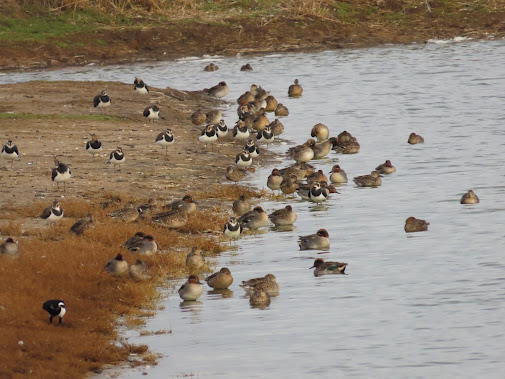November can be a strange month, Autumn is pretty much over and Winter is yet to come. As a result it can be a quiet time and is probably the month in which I have seen the fewest species. November is chiefly a month of wildfowl, when winter birds arrive after fleeing the cold weather on the continent. Minsmere is a good place to see the arrival of these winter birds, and having not visited for a couple of months decided to go have a look in the off chance something rare had turned up. The recent temperatures have been mild, which has resulted in only small numbers of winter birds turning up so far.
Unfortunately wildfowl were low on the ground across the reserve. To preserve the large colony of breeding birds on the Scrape, a lot of maintenance work is needed to provide optimum conditions for them to nest on. This time of year is usually the time when maintenance work is carried out, so as to cause the least disturbance. As a result there has been massive disturbance on the Scrape, and only South Scrape held any birds, the other parts were empty. Reeds had been cut back from the edges, and the islands had been dug up to get rid of any vegetation on them, as most breeding birds on the Scrape need open areas to nest in. Usually if birds are disturbed from the Scrape, they usually fly to the Levels, the area of wet grassland in the south of the reserve, but with water levels still low there, the area was unable to sustain any birds. Island Mere, a place that is usually a good bet for ducks, was also pretty empty, the area of reeds in front of the hide had been cut back.
There were still a few DUCKS and GEESE about though. Most interesting was a PINK FOOTED GOOSE, among a flock of GREYLAGS around the pool on the Levels. The Pink-Foot was a lot smaller than the greylags, and had a darker plumage, and also the bird had a dark bill, with a slight bit of pink on it. Although a common winter bird in Norfolk, its fairly unusual this far south in Suffolk, and this is only my second record for Minsmere. The usual TEAL, WIGEON, SHOVELLER and GADWALL were present on South Scrape, along with a female PINTAIL, a fairly scarce bird at Minsmere.
In the winter months WADERS are usually absent from Minsmere, and not much was about today. Two AVOCETS, and a TURNSTONE hanging out with the flock of fifty or so LAPWING on South Scrape. A YELLOW LEGGED GULL was a nice find on South Scrape, a bird almost identical to a herring gull, the obvious difference between these two birds are the leg colour, but it also had a cleaner head than the nearby herring's it hung out with. This bird is the form of herring gull found around the Mediterranean, and is a pretty common bird down there, occasionally wandering up to England.
One of my favourite birds is the BULLFINCH, a very charismatic bird, beautifully plumaged, with a black cap, a rich rose chest, a grey back, and a big old bill, as well as its distinctive white rump when seen in flight. Its melancholy call is very distinctive and is a good way to look for them in the bushes they hang out in. Today two males were present, one in the North Bushes, and one in the Sluice Bushes in the Dunes, the typical bushy habitat of this bird. I often see them at this time of year, and the birds are probably migrants in from the continent. Minsmere is a very good place to see STONECHATS, and five were present today, one along the North Wall, and four on the Dunes, they are very showy birds, always perched on a bush, ready to be appreciated. An unusual visitor to Minsmere was a KINGFISHER which was briefly seen flying across the back of Island Mere, alighting on a reed before disappearing behind. At the visitor centre, the bird feeders are a good place to appreciate the huge numbers of the smaller birds that call Minsmere home. In among the large number of commoner birds there were plenty of COAL TITS, with singles of NUTHATCH and MARSH TIT.
A quiet showing at Minsmere made by disturbance caused by maintenance work on the Scrape. As a result birding was brief as a look in North, East and West Hides produced no birds, as the areas in front of them were empty. These things are bloody annoying, but in the end are necessary for the thousands of birds that make Minsmere home in the summer months, which create the spectacle us birdwatchers come for. A place as good as Minsmere needs an intensive upkeep to keep it so good, as intensively managed as any farm.






No comments:
Post a Comment